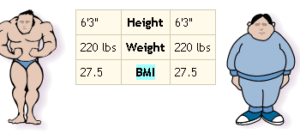
A report says that lean people have an increased risk of death five years after a heart attack, but there’s a flaw in this report.
So if you’re plus size, don’t rejoice just yet.
Plus size or not, you may be stunned to learn about the findings that were presented at the ESC Congress 2013 by French researchers, that lean heart attack survivors (along with very obese and those with disproportionately big bellies) are at increased risk of mortality five years out.
The term “lean” is misleadingly used in the French study. Perhaps “skinny-fat” should have been used instead.
Heart Attack Mortality Risk in Skinny-Fat Survivors vs. Lean Survivors
The paper states that both lean subjects and very obese ones had an increased risk of death after five years.
In addition, high waist girth, severe obesity and also underweight were associated with the biggest risk of death in those who’d had a heart attack.
These results are based on BMI (body mass index) calculations as well as waist circumference.
The paper had actually used the term “underseight,” not just “lean.”
To fitness professionals, the term “lean” is NOT the same as “underweight,” “slender,” “thin” or “skinny.”
In fact, a man who stands 5-9 and weighs 220 pounds could actually be very lean!

Freepik.com, Racool_studio
And a woman who wears a size 6 can actually have excess visceral fat (fat around the vital organs including the heart)!
The Problem with BMI
BMI is a value that results from a calculation involving one’s height and weight. Period.
BMI does not reveal body composition. It’s quite fair for me to wonder, then, if those “lean” heart attack survivors with that increased mortality risk had the so-called skinny-fat bodies.
A skinny-fat person appears “lean,” slender, lanky or thin in terms of size, but their body composition tells a different story.

Shutterstock/Sorn340 Images
If a personal trainer were to take a caliper skin-fold reading of a skinny-fat person to determine body fat percentage, the result would likely be a number in the “acceptable” range.
But according to the American Council on Exercise, the “acceptable” range for women is 25 to 31 percent, and for men it’s 18-24 percent.
If a person who appears slim, lanky or underweight has a body fat percentage in these ranges (gender considering), they will appear soft or flabby, despite being able to wear a size 6 or 8 dress or a slim-fit suit.
What body fat percentage would indicate “lean,” in the true sense of the word, according to ACE?
For women, 14-20 percent, and for men, 6-13 percent. Though a person who’s literally starved (such as from anorexia nervosa) will have an exceedingly low body fat percentage, they’ll also have an exceedingly low amount of muscle.
A lean person who works out and eats healthy, however, will have plentiful muscle mass while having low body fat. They are healthy-fit lean, not skinny-fat.
This is why BMI is worthless to athletes, especially physique specialists and bodybuilders. Their BMIs are often in the “overweight” range, yet their body fat percentages are very low.

I’d love to know what the body fat percentages and muscle volume levels were of those “lean” heart attack survivors in Professor Simon’s study.
I do not believe these heart attack survivors’ body compositions were comparable to those of athletes and physique specialists, even though dress-size-wise or suit-size wise, they can be interchangeable with athletes and physique enthusiasts.
If BMI is so misleading, why is it used in heart attack research?
Because it’s super easy! Often, research involves investigating and tracking up to hundreds of thousands of people.
Imagine the hairy logistics involved in getting a skin-fold reading on every one of them!
On the other hand, to get the BMI, all the researchers need do is get the patient’s height and weight from medical records. How easy is that?
When medical researchers use the word “lean,” consider the possibility that what they’re referring to is dress or suit size rather than body composition.
Having higher levels of body fat, even if the person has a slender frame, increases risk of health ailments including cardiac-related.
Hopefully, you now know why thinner heart attack survivors were found to have an increased risk of five-year mortality.


























